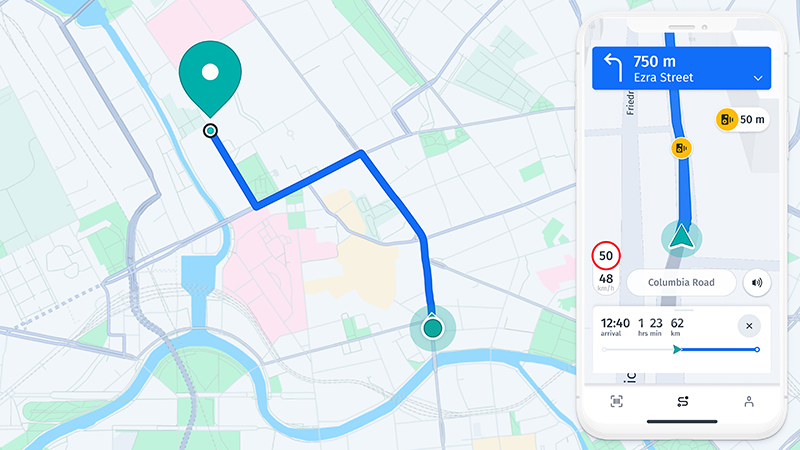With 3D map tools and location-based marketing booming, 2023 was one of the biggest years yet for location-based services. From delivery and logistics to contextual advertising, location mapping continues to be the critical tool in any organization’s digital arsenal.
Whether you’re building a new product or looking to revamp your current offering, there’s never been a better time to start looking. Competition between location platforms is tough, with some jaw-dropping new features coming to market nearly every month. So where do you start?
As a leading provider of location intelligence and data solutions, Local Eyes works closely with a wide range of firms to produce premium maps products. To help you make an informed decision, we’ve put together a comparison of all the major mapping platforms in 2024, including HERE Maps, TomTom, Mapbox, Openstreetmap, and Google Maps.
HERE Maps
Of all the location platforms on the market, HERE is above and beyond the leading solution. An independent report by Counterpoint Research found HERE leading in 8 out of 10 categories including Maps Data, Location Intelligence, AI capabilities, Developer Ecosystem, Platform and many other subcategories.
Over the last year, HERE introduced a major new AI-driven mapping technology known as Unimap. This highly automated system can detect changes in the physical world using vehicle and sensor data and extract new features – which are then shown on the map within 24 hours.
That means constant updates to things like speed limits, road signs, and route closures–giving users the ability to rapidly create their own private maps. It’s rolling out to general release throughout the year, meaning there’s never been a better time to get onboard with HERE.
While HERE Maps ticks a lot of boxes, its SDK size is admittedly quite large.
TomTom
Coming in at second place on Counterpoint’s report, the once-dominant TomTom is quickly closing in on HERE thanks to a brand refresh, revamped developer portal, and AI-based voice assistant (which trumps even HERE and Google).
Along with HERE, it leads Counterpoint’s location platform effectiveness rankings with strengths in the automotive, retail, enterprise, transport and logistics sectors. On top of that, TomTom is really focused on developing autonomous driving solutions, so it’s a great option for those forward-thinking transportation providers.
Users can expect strong traffic data analytics – both real-time and historical – but unlike HERE Maps, it only updates its maps once per month which could be a limiting factor.
Mapbox
If you’re after something with a wide number of styling options, Mapbox could be the one. It’s popular among organizations that want to add their own brand flair to their map tools.
Mapbox ALSO promises enterprise-grade encryption of all data uploaded via Mapbox Studio and its Upload API, meaning it’s a great option for the security-conscious. On top of that, its free tier is popular with several major apps and websites.
The main downside to Mapbox, however, is the lack of a customisable API–a must-have for any firm focused on building bespoke logistics solutions. While it has daily map data updates and a small SDK size, live traffic data has a roughly 3-minute delay–and its services can only be accessed via web.
Openstreetmap
Built on an open-source, free platform powered by community-driven data updates, Openstreetmap is a fantastic mapping platform. Whether you’re part of an organization seeking a highly customisable solution that empowers your developers, or you’re just after a cheaper option, OpenStreetMaps has low start-up costs and in many cases is free.
Unlike some of the other solutions listed in this article, OpenStreetMap admittedly falls short in terms of its routing and navigation features–especially when it comes to real-time traffic data, AI and route mapping. This is something that could be improved through customizing the API, so as long as you’ve got a strong developer capability, Openstreetmap is a viable option.
Google Maps
Finally, let’s talk about the Goliath in the room: Google Maps. There’s no doubt that Google Maps is one of the most popular map platforms. It boasts billions of downloads, with many of these being consumer Android users. It also benefits from a lively app developer ecosystem and, of course, easy integration with many of Google’s own tools.
But there are some downsides to going with Google. It doesn’t perform nearly as highly as HERE or TomTom on Counterpoint’s location platform index and with good reason. Google Maps was widely criticized for cutting the number of API calls developers could make on its freemium plan as well as controversial changes to pricing.
Google has admittedly made some strides in improving user privacy, particularly with location history, which is now wiped clean every 3 months rather than every 18 months. The firm also has the edge in terms of AI competencies over some of the smaller competitors. So while it’s still a strong option, it’s a good idea to do your research and look for something that suits your needs.
Choosing a mapping provider isn’t easy, but we hope this list helps to give you a better idea of your options. Local Eyes is the Netherlands’ leading provider of location intelligence and mapping solutions. If you’d like to schedule a call to get some more detailed advice, get in touch with us today.





